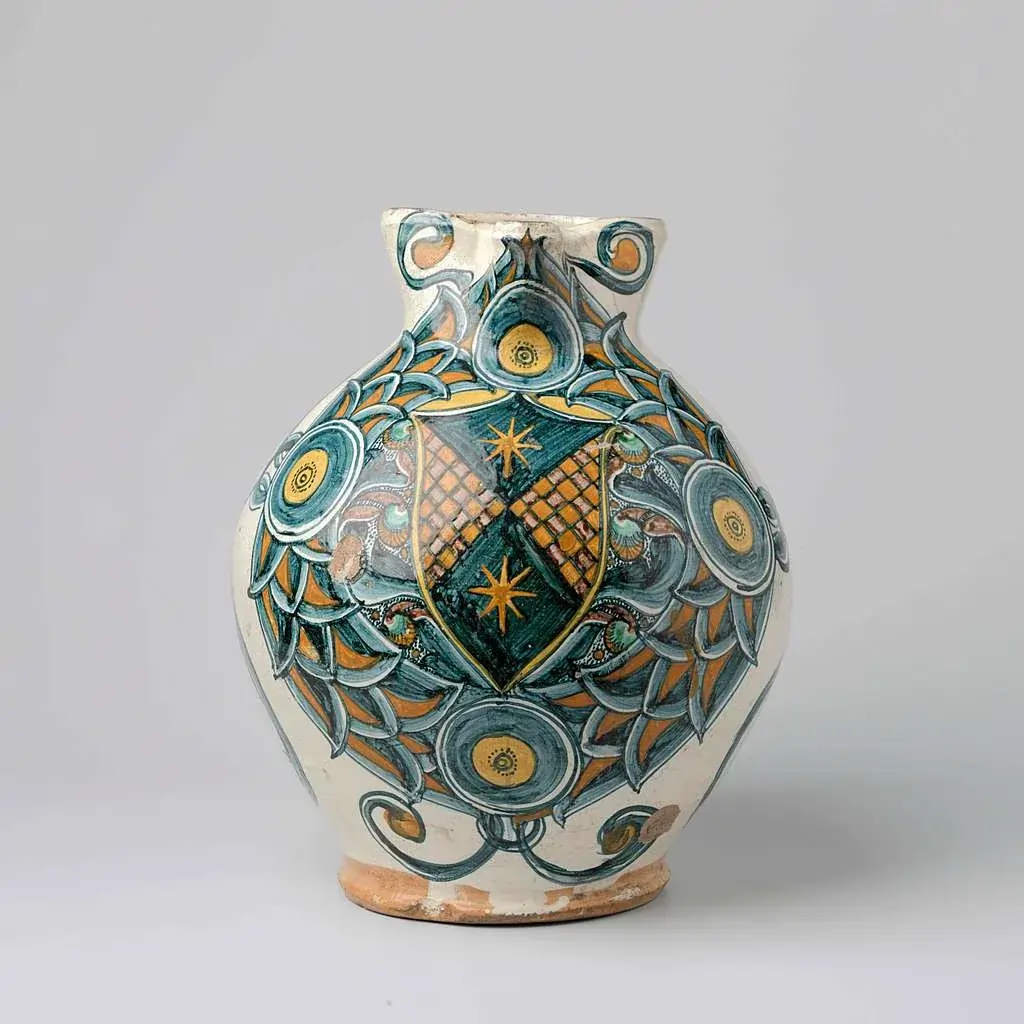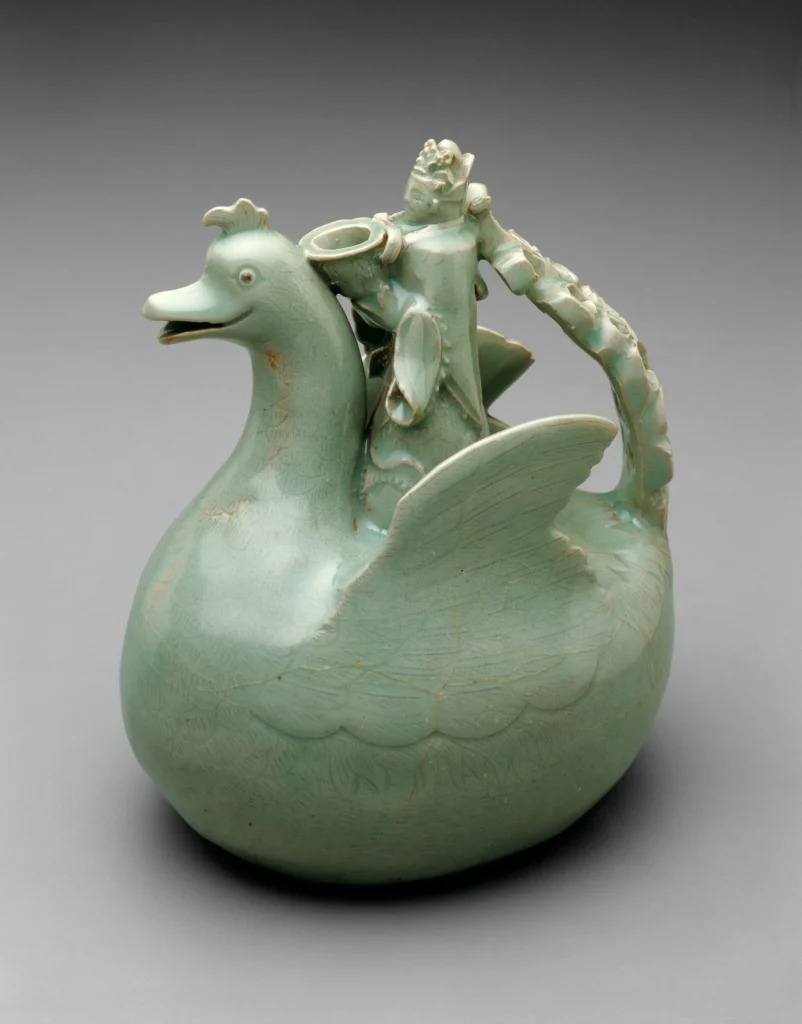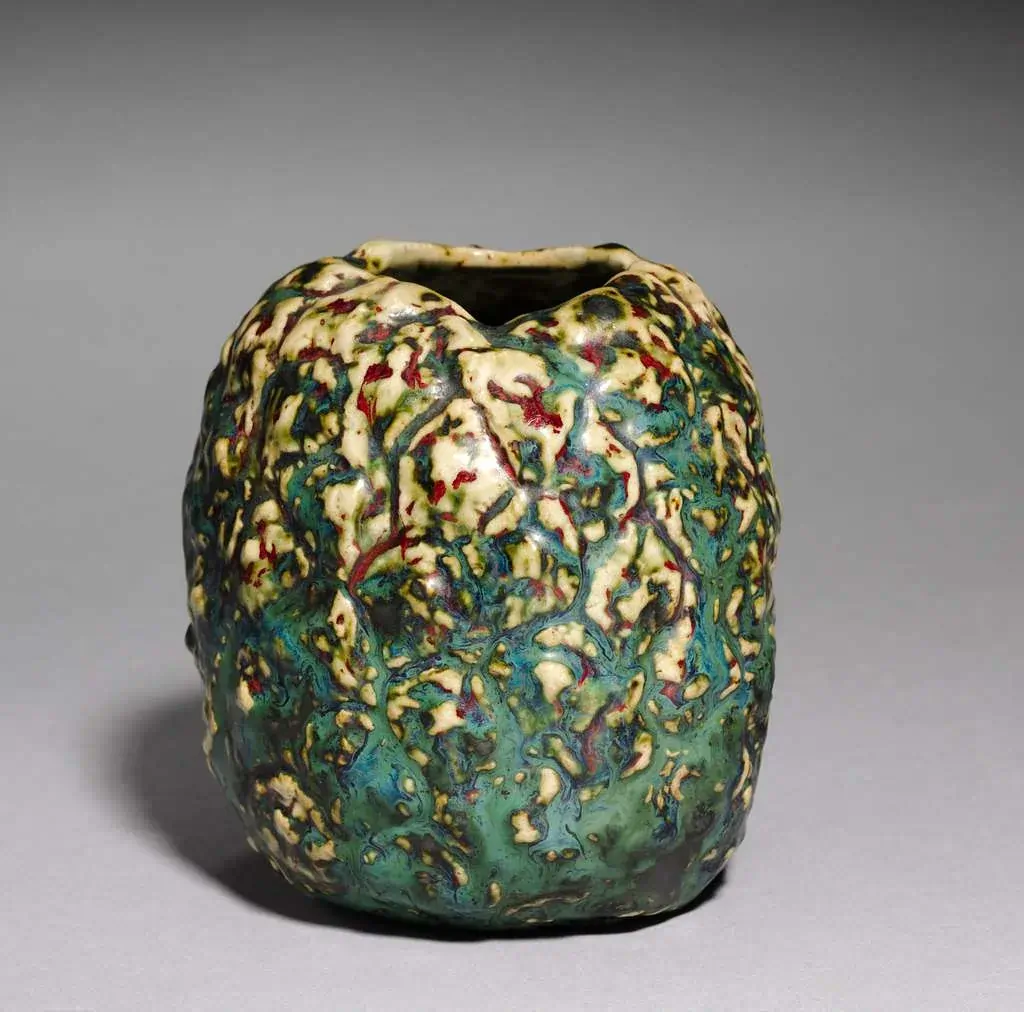Authentic pieces of Majolica pottery can command prices at auctions, with some fetching thousands of dollars; however experts believe that 40% of the pieces available, in the current market are actually reproductions.
In our role, as collectors of art and antiques we frequently come across majolica pottery, in stores, estate sales and online platforms. Differentiating between pieces and modern reproductions demands expertise and meticulous scrutiny.
Are you a collector or new, to exploring the realm of majolica? This detailed handbook will equip you with the skills employed by experts to confidently discern pieces.
Understanding Majolica Pottery Fundamentals
Let’s dive into the world of majolica by delving into its core essence as a type of pottery made from earthenware clay pots and plates. Despite the name hinting at its roots, on Majorca Island the methods employed to craft majolica pieces actually date back, to Assyrians residing in the Middle East region.
Definition and Historical Background
The art of Majolica pottery is truly impressive, with its use of tin glazed earthenware and colorful decorative designs. It first appeared in Italy around the 1300s with a focus on green and purplish brown hues. As time went on during the Renaissance era the craft advanced greatly as artists introduced a range of colors such as blues, yellows and oranges along, with beautiful turquoise shades.
Key Manufacturing Techniques
The creation of authentic majolica follows a precise five-step process:
- Clay Formation: The process begins with refined clay shaped by Il Torniante (the potter)
- Prima Cottura: First firing at 950 degrees, creating the biscotto (bisque)
- Smaltatura: Application of the distinctive white tin-based glaze
- Hand Painting: Decoration with colored glazes
- Seconda Cottura: Final firing at 920 degrees to achieve the characteristic shine
Different Types of Majolica
We recognize several distinct varieties of majolica, each with unique characteristics:
| Type | Period | Key Features |
| Italian Renaissance | 14th-16th century | Religious themes, mythological scenes |
| Victorian | 1851-1900 | Molded relief, naturalistic designs |
| Continental | Late 19th century | Regional European variations |
| American | 1870-1920 | Agricultural themes, seashell motifs |
The way things are made stays much the same for all these types even though nowadays manufacturers tend to go for made frit instead of the old school tin glazes which was more common back, in the day when verifying the authenticity of items. It’s a major distinguishing factor, between old and new creations.
Physical Authentication Markers
When we assess majolica pottery, for authenticity we heavily depend on their features, as reliable indicators. Through our experience we’ve observed that authentic pieces display qualities that contemporary reproductions frequently struggle to imitate accurately.
Weight and Material Composition
Authentic majolica pottery tend to be noticeably heavy because of their earthenware material composition—the clay body should have a sturdy quality compared to modern replicas typically found on the market today. When inspecting the base of these items, for authenticity cues; European pieces often show clay body areas when exposed while reddish tan clay might indicate a recent reproduction—it’s crucial to keep an eye out for these subtle differences during evaluation.
Glaze Characteristics and Colors
The glaze characteristics of authentic majolica provide crucial authentication clues:
| Authentic Trait | What We Look For |
| Glaze Coverage | Even application with minimal drips |
| Color Quality | Rich, vibrant but not gaudy |
| Crazing Pattern | Natural, irregular network of fine cracks |
| Surface Finish | Brilliant, glossy without excessive shine |
We pay special attention to crazing patterns, as authentic pieces display natural aging characteristics. Modern reproductions often show suspiciously uniform crazing patterns that lack the organic development found in period pieces.
Surface Texture and Relief Patterns
In examining surface characteristics, we focus on several key indicators:
- Relief Definition: Authentic pieces show crisp, well-defined molded patterns
- Interior Surfaces: Should be smooth without showing through of exterior patterns
- Edge Treatment: All edges should be rounded, particularly on vessel lips
- Handle Construction: Solid construction rather than hollow forms
In genuine majolica pottery you can see a level of craftsmanship in the intricate molded designs and patterns are thoughtfully executed with precision and care, in mind for the glazing process to follow the shapes accurately without any messy or hurried application that you might find in newer pieces trying to emulate the style.
When we inspect the insides closely for smooth and even finishes. Notice the patterns texture seeping through on the inside instead of traditional press molding methods used in modern reproductions created through slip casting techniques.
Examining Manufacturer Marks
Manufacturer marks are essential, for verifying the authenticity of majolica items; however it’s important to remember that not all authentic pieces come with these marks on them. Having studied pieces extensively over time has enabled us to establish a way of comprehending and recognizing these significant tools used for authentication purposes.
Common Factory Signatures
Leading manufacturers such, as Minton, Wedgwood and George Jones were meticulous in how they marked their products. Minton was known for impressing “MINTON” onto the clay sometimes requiring a look due, to glazing that could partially cover these marks. In 1873, the marking was altered to “MINTONS.” Wedgwood pieces typically featured a WEDWOOD “mark. George Jones utilized a unique monogram of “GJ” often overlapping each other.
Date Marks and Registration Numbers
The British Registry Office implemented a diamond-shaped registration mark system that we find particularly helpful in dating pieces. This system, operational from 1842 to 1883, provides specific information:
| Mark Component | Location | Information Provided |
| Day Code | Right (1842-1867), Top (1868-1883) | Day of Registration |
| Month Code | Left (1842-1867), Bottom (1868-1883) | Month of Registration |
| Year Code | Top (1842-1867), Right (1868-1883) | Year of Registration |
Wedgewood had a way of dating their pieces in 1860 using a three letter system; the first letter denoted the month of production; the second indicated the potter responsible; and the third revealed the year it was made.
Regional Variations in Markings
During our study of artworks and pottery items, from the 19th century onwards we noticed specific trademarks and signatures on various pieces. Griffin along with Smith and Hill were known craftsmen who labeled their creations as “Etruscan” Ware starting from the year 1879. Another noteworthy pottery maker was Chesapeake Pottery that commenced its operations in 1882 They introduced markings for their Avalon Faience collection Which stood out due, to its colored design adorned with golden accents.
We need to be careful when inspecting markings because current replicas may intentionally hide or imitate marks at times. In our investigations far we’ve discovered that manufacturers were not always uniform. Some labeled all items whereas others only marked pieces in a collection. When faced with items we depend on verification techniques such, as studying unique glazes and contrasting them with known samples.
Scientific Authentication Methods
The progress, in science has transformed the way we verify majolica artifacts, with our research and experiments leading to the creation of approaches that enhance visual examination methods.
UV Light Testing
In our laboratory, with lighting conditions we use wave black lights for examining majolica pieces and uncover hidden details effectively, under ultraviolet light scrutiny.
| Material Component | UV Light Reaction |
| Hard-paste porcelain | Deep blue/purple fluorescence |
| Soft-paste porcelain | White fluorescence |
| Modern repairs | Bright fluorescence |
| Pre-1930s materials | Minimal to no glow |
The key to successful UV testing lies in proper examination conditions. We conduct our tests in completely darkened rooms to prevent interference from ambient light sources.
Microscopic Analysis
Through scanning electron microscopy (SEM-EDX), we examine the intricate details of majolica surfaces. Our analysis focuses on:
- Glaze homogeneity and thickness
- Distribution of color decorations
- Presence of microscopic inclusions
- Surface layer composition
Through our research findings indicate that genuine items exhibit features when examined closely with a microscope. The coating ought to give the impression of being a consistent substance when observed in profile.
Chemical Composition Testing
We use micro X-ray fluorescence (μ-XRF) for our chemical analysis, which is an invasive method that has transformed how we authenticate majolica pieces. This approach helps us identify the chemical composition of surface glazes without causing harm to the artifact.
By using neutron activation analysis (INAA) we can pinpoint elements that confirm the composition of ceramic paste focusing on specific markers.
- Formation Elements: Scandium, Chromium, Iron, and Rare Earth Elements
- Mineral Indicators: Sodium, Potassium, Calcium, and Titanium
- Glaze Components: Lead content (typically 22-27%) and silica ratios
During our analysis of ornaments and embellishments is when we apply mapping to pinpoint the pigments that were popular, during that period of time accurately. This method allows us to differentiate between styles and local variations especially evident, in decorations featuring cobalt hues.
The use of these techniques gives us information, about the authenticity of an item we come across in our work field. When we come across items frequently we notice chemical markings that differ greatly from compositions expected for that time period.
Spotting Modern Reproductions
In the world of majolica trading industry today we are witnessing a rise, in contemporary replicas that pose a challenge even for seasoned collectors out there. Our extensive years of validating items have shown us that grasping these pieces is essential, for safeguarding your collection.
Common Reproduction Characteristics
Modern majolica pottery reproductions, particularly those manufactured since the 1950s, display distinct characteristics that set them apart from authentic pieces. We’ve observed that reproduction pieces typically exhibit:
| Characteristic | Reproduction Trait | Authentic Trait |
| Weight | Notably lighter | Substantial, heavy |
| Glaze Quality | Often runny, uneven | Controlled, precise |
| Color Palette | Harsh, garish | Rich, harmonious |
| Surface Detail | Less crisp modeling | Sharp, defined relief |
| Interior Finish | Often shows exterior pattern | Smooth, independent finish |
Known Fake Markings
Through our examination of thousands of pieces, we’ve identified several telltale signs of fake markings. Modern reproductions often attempt to deceive through:
- Distorted versions of authentic factory marks
- Black ink Etruscan marks (particularly from Asian manufacturers)
- Removable paper labels concealing modern origins
- Diamond-shaped registry marks that don’t match historical patterns
Many contemporary items, from Wanjiang in China were first introduced to the market without any identification except for paper labels attached to them; eventually makers marks were imprinted on them in later versions but some sellers remove these markings to pass off the items, as antiques.
Red Flags in Construction
Our experience has taught us to watch for specific construction elements that signal modern reproduction:
- Interior Surface Treatment
- Unglazed interiors (particularly in functional pieces)
- Pattern texture showing through from exterior
- Inconsistent glaze application
- Manufacturing Indicators
- Slip-casting evidence instead of press-molding
- Excessive glaze pooling in relief areas
- Artificially stressed surfaces attempting to mimic age
Modern manufacturers frequently opt for production methods that lead to the creation of items lacking the craftsmanship found in genuine majolica pieces. An example of this is observed in the case of replicated oyster plates originating from South Carolina; initially priced at $35 when first sold but later showing up in resale markets at escalated prices due, to manipulation, by dealers.
The difference, in quality is especially noticeable in items, like cheese bells which now showcase pointed finials instead of the classic cheese slice design and have glazes that seem messy and less refined compared to the flawless finish of genuine pieces.
While evaluating buys we focus on signs of wear and tear. Original items tend to exhibit aging whereas fake items may show manufactured aging without the signs of natural wear. Made replicas can give themselves away with their precise and mechanical glaze application missing the unique touch of genuine majolica craftsmanship.
Pricing plays a role, in how we authenticate items in our process. The team pays attention when we come across pieces that are priced below market value especially when there are a lot of them available, in one go .The majolica market has its pricing norms and any major deviations usually point towards the possibility of reproductions being involved.
Conclusion
Authenticating majolica pottery requires a blend of accuracy and extensive practical know how accumulated over years of hands on engagement, in the field. Successful authentication entails an inspection of attributes alongside a deep understanding of makers marks; occasionally necessitating the utilization of advanced scientific testing techniques. Our investigations reveal that collectors who adeptly grasp these authentication methods shield themselves from the surge, in imitations infiltrating the market.
The unique features of majolica. Such, as its weight and meticulous glazing along with the distinctive crackling patterns. Narrates a tale of skilled artisanship that contemporary replicas find challenging to emulate accurately. While scientific techniques offer evidence of legitimacy having a trained eye and keen observation skills are assets, for collectors.
With this understanding, in mind we urge collectors to evaluate each purchase with a discerning eye and a patient approach. The lasting value and artistic importance of majolica items justify the time spent on authentication which safeguards the integrity of collections and upholds the legacy of this exceptional ceramic craft.
FAQs
How can I determine if my majolica pottery is authentic?
Authentic majolica pottery is known for its vibrant, richly colored glazes. Antique majolica pieces exhibit meticulous glazing without imperfections such as drips or runs, which are more commonly seen in modern reproductions that tend to have overly bright and garish colors.
What markings are typical on majolica pottery?
Majolica pottery often features a diamond-shaped mark that indicates the registration of the pattern. This mark includes letters and numbers in its four corners, which specify the exact date of registration. This marking system was widely used during the majolica period and continued thereafter.
Is it possible for majolica to have no markings?
Yes, it is quite common for majolica pottery to be unmarked. Many manufacturers, including some of the top ones, frequently did not mark their wares. Therefore, the absence of a maker’s mark does not necessarily indicate that a piece is not authentic.
What are the typical characteristics of majolica pottery?
Majolica, also known as tin lead glazed pottery, is characterized by a creamy, light-buff colored ceramic body. It is covered with an opaque white tin-lead glaze that coats the entire outer surface of the piece.
How can I identify an authentic majolica plate?
To identify an authentic majolica plate, check for the quality of the glaze, which should be even and lustrous without any crazing, drips, or imperfections. Crazing in the glaze can occur due to age but should be minimal. Authentic majolica also features vibrant, well-applied colors.



